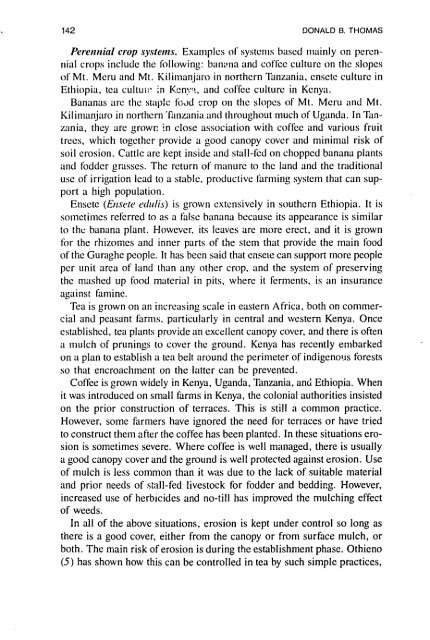Conservation farming on steep lands - USAid
Conservation farming on steep lands - USAid
Conservation farming on steep lands - USAid
You also want an ePaper? Increase the reach of your titles
YUMPU automatically turns print PDFs into web optimized ePapers that Google loves.
142 DONALD B. THOMAS<br />
Pererztrinl crop systetrts. Examplcs of systems bascd mainly <strong>on</strong> perennial<br />
crops include the fi~llowing: banrna and coffee culture <strong>on</strong> thc slopes<br />
of Mt. Mcru and Mt. Kilimanjaro in northern Tanzania, enscte culturc in<br />
Ethiopia, tea cultui:- in Ken:;-1, and coffcc culture in Kcnya.<br />
Bananas are the staple fc,,)d crop <strong>on</strong> the slopes of Mt. Meru and Mt.<br />
Kilimanjaro in northern 'Ciinzania and throughout much of Uganda. In Tinzania,<br />
they are growr n close associati<strong>on</strong> with coffee and various fruit<br />
trccs, which togcther provide a good canopy cover and minimal risk of<br />
soil crosi<strong>on</strong>. Cattlc ilre kept inside and stall-fed <strong>on</strong> chopped banana plants<br />
and fodder grasses. The return of manure to the land and the traditi<strong>on</strong>al<br />
use of irrigati<strong>on</strong> lead to a stable, productive <str<strong>on</strong>g>farming</str<strong>on</strong>g> systcm that can support<br />
a high populati<strong>on</strong>.<br />
Ensctc (Etrsete eclltlis) is grown cxtcnsivcly in southern Ethiopia. It is<br />
sometimes referred to as a falsc banana because its appearance is similar<br />
to the banana plant. However, its leaves are more erect, and it is grown<br />
for the rhizomes and inner parts of the stem that provide the main food<br />
of the Guraghc people. It has been said that ensete can support more people<br />
pcr unit area of land than any other crop. and the system of prcscrving<br />
the mashed up food material in pits, where it ferments, is an insurance<br />
against famine.<br />
Tca is grown <strong>on</strong> an incrcasing scale in eastern Africa, both <strong>on</strong> commercial<br />
and peasant farms. particularly in central and western Kenya. Once<br />
established, tea plants provide an exczllent canopy covcr, and there is often<br />
a mulch of prunings to covcr the ground. Kenya has recently embarked<br />
<strong>on</strong> a plan to establish a tea belt around the perimeter of indigenous forests<br />
so that encroachment <strong>on</strong> the latter can be prevented.<br />
Coffee is grown widely in Kenya. Uganda, Tanzania, and Ethiopia. When<br />
it was introduced <strong>on</strong> small farms in Kcnya, the col<strong>on</strong>ial authorities insisted<br />
<strong>on</strong> the prior c<strong>on</strong>structi<strong>on</strong> of terraces. This is still a comm<strong>on</strong> practice.<br />
However, some farmers have ignored the need for terraces or have tried<br />
to c<strong>on</strong>struct them after the coffee has been planted. In these situati<strong>on</strong>s erosi<strong>on</strong><br />
is sometimes severe. Where coffee is well managed, there is usually<br />
a good canopy cover and the ground is well protected against erosi<strong>on</strong>. Use<br />
of mulch is less comm<strong>on</strong> than it was due to the lack of suitable material<br />
and prior needs of stall-fed livestock for fodder and beddicg. However,<br />
increased use of herbicides and no-till has improved the mulching effect<br />
of weeds.<br />
In all of the above situati<strong>on</strong>s, erosi<strong>on</strong> is kept under c<strong>on</strong>trol so l<strong>on</strong>g as<br />
there is a good cover, either from the canopy or from surface mulch, or<br />
both. The main risk of erosi<strong>on</strong> is during the establishment phase. Othieno<br />
(5) has shown how this can be c<strong>on</strong>trolled in tea by such simple practices,
















